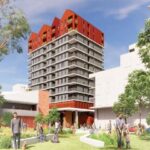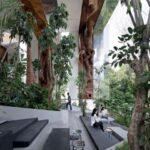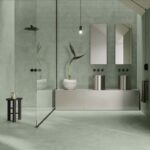Hamman Spa at Ressano Garcia – Architecture that nurtures
Architecture hosts both the mind and the body. Each person perceives the physical world through enigmatic intimate reactions.
The body knows human beings’ common needs and learns about the built environment. The mind is able to interpret architecture using other tools.

GALLERY





The central question is do senses influence the architect or the senses are enhanced by architecture design? These are the questions the architects for the Hammam Spa at Ressano Garcia in Portugal tried to answer.
Interior spaces are organized by their temperatures (hot, warm and cold). Inside the hot room, the steam improves the sense of the body. Sweat increases the smell of the body and softens the skin, offering a profound physical experience, closely related to the intimacy of lovers.
In the next room, the warm room has generous benches built in marble with comfortable angles and round edges, they softly touch the skin. It is a space for sensual pleasures where each detail matters.
In the plans, the geometry of the room presents an oval shape and the cross-section shows a parabolic shape. It is intentionally designed with curves and the combination of the round plan and section enhances a particular spatial experience. A space that is smooth, without corners or angles; that is continuous and round suggests similarities to the womb. The sensuality of the experience is amplified by the shape of the building’s design.
The light inside offers a spiritual experience, enriched by the sound of regular dripping of water that smoothes the atmosphere to complete relaxation. The project was designed in close collaboration with clients Eglantina Monteiro and Francisco Palma Dias. Eglantina is an anthropologist and art curator who holds a deeper perception of local context and their cultural relations. Francisco is a poet and a surreal farmer who claimed the necessity to remake the traditional public baths, that is to say, the Hammam.
To him, public baths, widely disseminated during the Roman Empire and continued by Muslims all around the Mediterranean, were consistently banned by the Catholic Kings during the Middle Ages. The design of a new Hammam in this particular region and in this specific period of time, the 21st century, is a statement at two levels; historic and geographic. The new building establishes a relation to the long lost practice. It opens a new perception where local culture is seen not just within its present context but also related to ancient traditions.
Images Francisco Nogueira via Arch Daily
Studio Tate has completed a lavish redesign of the 17th floor of a distinctive hexagonal building in Melbourne, ...
Red sculptural interventions define the interior of ARKS’ new flagship store in Bandra West, Mumbai, where Anagram Architects ...
Work is set to begin on a new 12-storey mixed-use affordable housing development in Adelaide’s inner north-west, marking ...
Frame Garden Café, known as Tanatap, represents another prototype in an evolving series of multi-level greenspaces that challenge ...
Italian brand Casalgrande Padana has built a reputation as a prolific producer of ceramic and stoneware tiles, translating ...








